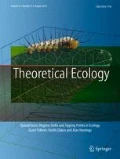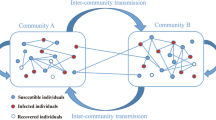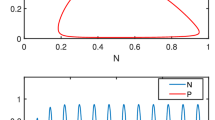Abstract
The dynamics of coupled populations have mostly been studied in the context of metapopulation viability with application to, for example, species at risk. However, when considering pests and pathogens, eradication, not persistence, is often the end goal. Humans may intervene to control nuisance populations, resulting in reciprocal interactions between the human and natural systems that can lead to unexpected dynamics. The incidence of these human-natural couplings has been increasing, hastening the need to better understand the emergent properties of such systems in order to predict and manage outbreaks of pests and pathogens. For example, the success of the growing aquaculture industry depends on our ability to manage pathogens and maintain a healthy environment for farmed and wild fish. We developed a model for the dynamics of connected populations subject to control, motivated by sea louse parasites that can disperse among salmon farms. The model includes exponential population growth with a forced decline when populations reach a threshold, representing control interventions. Coupling two populations with equal growth rates resulted in phase locking or synchrony in their dynamics. Populations with different growth rates had different periods of oscillation, leading to quasiperiodic dynamics when coupled. Adding small amounts of stochasticity destabilized quasiperiodic cycles to chaos, while stochasticity was damped for periodic or stable dynamics. Our analysis suggests that strict treatment thresholds, although well intended, can complicate parasite dynamics and hinder control efforts. Synchronizing populations via coordinated management among farms leads to more effective control that is required less frequently. Our model is simple and generally applicable to other systems where dispersal affects the management of pests and pathogens.





Similar content being viewed by others
References
Aaen SM, Helgesen KO, Bakke MJ, Kaur K, Horsberg TE (2015) Drug resistance in sea lice: a threat to salmonid aquaculture. Trends Parasitol 31(2):72–81. doi:10.1016/j.pt.2014.12.006. http://linkinghub.elsevier.com/retrieve/pii/S1471492214002098
Abbott KC (2011) A dispersal-induced paradox: synchrony and stability in stochastic metapopulations. Ecol Lett 14(11):1158–1169. doi:10.1111/j.1461-0248.2011.01670.x
Adams T, Black K, Macintyre C, Macintyre I, Dean R (2012) Connectivity modelling and network analysis of sea lice infection in Loch Fyne, west coast of Scotland. Aquaculture Environ Interactions 3:51–63. doi:10.3354/aei00052. http://www.int-res.com/abstracts/aei/v3/n1/p51-63/
Aldrin M, Storvik B, Kristoffersen AB, Jansen PA (2013) Space-time modelling of the spread of salmon lice between and within Norwegian marine salmon farms. PLoS ONE 8(5):e64, 039. doi:10.1371/journal.pone.0064039
Becks L, Arndt H (2013) Different types of synchrony in chaotic and cyclic communities. Nat Commun 4:1359. doi:10.1038/ncomms2355. http://www.ncbi.nlm.nih.gov/pubmed/23322047
Birch L (1948) The intrinsic rate of natural increase of an insect population. J Anim Ecol 15–26. www.jstor.org/stable/1605
Bolker BM, Grenfell BT (1996) Impact of vaccination on the spatial correlation and persistence of measles dynamics. Proc Natl Acad Sci 93(22):12,648–12,653. http://www.pnas.org/content/93/22/12648.abstract
Bricknell IR, Dalesman SJ, O’Shea B, Pert CC, Luntz AJM (2006) Effect of environmental salinity on sea lice Lepeophtheirus salmonis settlement success. Dis Aquat Org 71(3):201–212. doi:10.3354/dao071201. http://www.int-res.com/abstracts/dao/v71/n3/p201-212/
British Columbia Ministry of Agriculture and Lands (2005) Fish Health Program 2003-2005. Tech. rep., Ministry of Agriculture and Lands, http://www.agf.gov.bc.ca/ahc/fish_health/Fish_Health_Report_2003-2005.pdf
Brooks KM (2009) Considerations in developing an integrated pest management programme for control of sea lice on farmed salmon in Pacific Canada. J Fish Dis 32(1):59–73. http://login.ezproxy.library.ualberta.ca/login?url=http://search.ebscohost.com/login.aspx?direct=true&db=eih&AN=36551408&site=ehost-live&scope=site
Brooks EN, Lebreton JD (2001) Optimizing removals to control a metapopulation: application to the yellow legged herring gull (Larus cachinnans). Ecol Model 136(2-3):269–284. doi:10.1016/S0304-3800(00)00430-0
Brown JHJ, Kodric-Brown A (1977) Turnover rates in insular biogeography: effect of immigration on extinction. Ecology 58(2):445–449. doi:10.2307/1935620. http://www.esajournals.org/doi/abs/10.2307/1935620
Chau NP (2000) Destabilising effect of periodic harvest on population dynamics. Ecol Model 127(1):1–9. doi:10.1016/S0304-3800(99)00190-8. http://www.sciencedirect.com/science/article/pii/S0304380099001908
Cheal AJ, Delean S, Sweatman H, Thompson AA (2007) Spatial synchrony in coral reef fish populations and the influence of climate. Ecology 88(1):158–69. doi:10.1890/0012-9658(2007)88[158:SSICRF]2.0.CO;2. http://www.ncbi.nlm.nih.gov/pubmed/17489464
Costello MJ (2009) How sea lice from salmon farms may cause wild salmonid declines in Europe and North America and be a threat to fishes elsewhere. Proc R Soc B Biol Sci 276(1672):3385–3394. doi:10.1098/rspb.2009.0771. http://rspb.royalsocietypublishing.org/content/276/1672/3385
Dey S, Goswami B, Joshi A (2014) Effects of symmetric and asymmetric dispersal on the dynamics of heterogeneous metapopulations: two-patch systems revisited. J Theor Biol 345:52–60. doi:10.1016/j.jtbi.2013.12.005
Dey S, Goswami B, Joshi A (2015) A possible mechanism for the attainment of out-of-phase periodic dynamics in two chaotic subpopulations coupled at low dispersal rate. J Theor Biol 367:100–110. doi:10.1016/j.jtbi.2014.11.028
Earn DJD, Rohani P, Grenfell BT (1998) Persistence, chaos and synchrony in ecology and epidemiology. Proc R Soc B Biol Sci 265(1390):7–10. http://rspb.royalsocietypublishing.org/content/265/1390/7.abstract
Earnshaw JC (1993) Lyapunov exponents for pedestrians. Am J Phys 61(5):401. doi:10.1119/1.17231. http://scitation.aip.org/content/aapt/journal/ajp/61/5/10.1119/1.17231
FAO (2014) The State of World Fisheries and Aquaculture 2014. Tech. rep., Food and Agriculture Organization of the United Nations, Rome. www.fao.org/publications
Foreman MGG, Chandler PC, Stucchi DJ, Garver KA, Guo M, Morrison J, Tuele D (2015) The ability of hydrodynamic models to inform decisions on the siting and management of aquaculture facilities in British Columbia. Canadian Science Advisory Secreteriat Research Document 2015/005:vii + 49, http://www.dfo-mpo.gc.ca/csas-sccs/
Franco D, Ruis-Herrera A (2015) To connect or not to connect isolated patches. J Theor Biol 370:72–80. doi:10.1016/j.jtbi.2015.01.029 10.1016/j.jtbi.2015.01.029
Frazer LN, Morton A, Krkošek M (2012) Critical thresholds in sea lice epidemics: evidence, sensitivity and subcritical estimation. Proc R Soc B Biol Sci 279(1735):1950–1958. doi:10.1098/rspb.2011.2210. http://rspb.royalsocietypublishing.org/content/279/1735/1950
Fulford G, Roberts M, Heesterbeek J (2002) The metapopulation dynamics of an infectious disease: tuberculosis in possums. Theor Popul Biol 61(1):15–29. doi:10.1006/tpbi.2001.1553. http://linkinghub.elsevier.com/retrieve/pii/S0040580901915539
Galvanetto U (2000) Numerical computation of Lyapunov exponents in discontinuous maps implicitly defined. Comput Phys Commun 131(1):1–9. doi:10.1016/S0010-4655(00)00055-2. http://www.sciencedirect.com/science/article/pii/S0010465500000552
Goldwyn EE, Hastings A (2011) The roles of the Moran effect and dispersal in synchronizing oscillating populations. J Theor Biol 289(1):237–246. doi:10.1016/j.jtbi.2011.08.033
Grenfell BT, Wilson K, Finkenstadt BF, Coulson TN, Murray S, Albon SD, Pemberton JM, Clutton-Brock TH, Crawley MJ (1998) Noise and determinism in synchronized sheep dynamics. Nature 394(6694):674–677. doi:10.1038/29291
Groner ML, Gettinby G, Stormoen M, Revie CW, Cox R (2014) Modelling the impact of temperature-induced life history plasticity and mate limitation on the epidemic potential of a marine ectoparasite. PLoS ONE 9:e88,465. doi:10.1371/journal.pone.0088465
Hastings A (1993) Complex interactions between dispersal and dynamics: lessons from coupled logistic equations. Ecology 74(5):1362–1372. 10.2307/1940066
Hastings A, Powell T (1991) Chaos in a three species food chain. Ecology 72(3):896–903. http://www.jstor.org/stable/1940591
Hastings A, Hom CL, Ellner S, Turchin P, Godfray HCJ (1993) Chaos in ecology: is Mother Nature a strange attractor?. Annu Rev Ecol Syst 24(1):1–33. doi:10.1146/annurev.es.24.110193.000245. http://www.jstor.org/discover/10.2307/2097171
Heggberget TG, Johnsen BO, Hindar K, Jonsson B, Hansen LP, Na Hvidsten, Jensen AJ (1993) Interactions between wild and cultured Atlantic salmon: a review of the Norwegian experience. Fish Res 18(1-2):123–146. doi:10.1016/0165-7836(93)90044-8
Hilborn R, Mangel M (1997) The ecological detective: confronting models with data, Monographs in Population Biology 28
Holt RD, McPeek MA (1996) Chaotic population dynamics favors the evolution of dispersal. Am Nat 148(4):709–718. doi:10.2307/2678832. http://www.jstor.org/stable/2556325
Igboeli OO, Burka JF, Fast MD (2014) Lepeophtheirus salmonis: a persisting challenge for salmon aquaculture. Anim Front 4(1):22–32. doi:10.2527/af.2014-0004. https://dl.sciencesocieties.org/publications/af/abstracts/4/1/22
Ives AR, Settle WH (1997) Metapopulation dynamics and pest control in agricultural systems. Am Nat 149(2):220–246
Jansen PA, Kristoffersen AB, Viljugrein H, Jimenez D, Aldrin M, Stien A (2012) Sea lice as a density-dependent constraint to salmonid farming. Proc R Soc B Biol Sci 279(1737):2330–2338. doi:10.1098/rspb.2012.0084. http://rspb.royalsocietypublishing.org/content/279/1737/2330.abstract
Johnson SC, Albright LJ (1991) Development, growth, and survival of Lepeophtheirus salmonis (Copepoda: Caligidae) Under Laboratory Conditions. J Mar Biol Assoc U K 71(02):425–436. doi:10.1017/S0025315400051687
Johnson SC, Albright LJ (1991) The developmental stages of Lepeophtheirus salmonis (Krøyer, 1837) (Copepoda: Caligidae). Can J Zool 69(4):929–950. doi:10.1017/S0025315400051687
Keeling MJ, Gilligan CA (2000) Metapopulation dynamics of bubonic plague. Nature 407(6806):903–906. doi:10.1038/35038073
Kendall BE, Fox GA (1998) Spatial structure, environmental heterogeneity, and population dynamics: analysis of the coupled logistic map. Theor Popul Biol 54(1):11–37. doi:10.1006/tpbi.1998.1365 10.1006/tpbi.1998.1365
Kristoffersen AB, Rees EE, Stryhn H, Ibarra R, Campisto JL, Revie CW, St-Hilaire S (2013) Understanding sources of sea lice for salmon farms in Chile. Prev Vet Med 111(1-2):165–75. doi:10.1016/j.prevetmed.2013.03.015. http://www.ncbi.nlm.nih.gov/pubmed/23628338
Krkošek M, Lewis MA, Morton A, Frazer LN, Volpe JP (2006) Epizootics of wild fish induced by farm fish. Proc Natl Acad Sci 103(42):15506–15510. doi:10.1073/pnas.0603525103. http://www.pubmedcentral.nih.gov/articlerender.fcgi?artid=1591297&tool=pmcentrez&rendertype=abstract
Krkošek M, Bateman A, Proboszcz S, Orr C (2010) Dynamics of outbreak and control of salmon lice on two salmon farms in the Broughton Archipelago, British Columbia. Aquaculture Environ Interactions 1(2):137–146. doi:10.3354/aei00014. http://www.int-res.com/abstracts/aei/v1/n2/p137-146/
Krkošek M, Connors BM, Morton A, Lewis MA, Dill LM, Hilborn R (2011) Effects of parasites from salmon farms on productivity of wild salmon. Proc Natl Acad Sci 108(35):14,700–14,704. doi:10.1073/pnas.1101845108. http://www.pnas.org/content/108/35/14700
Lande R, Engen S, Sæther B (1999) Spatial scale of population synchrony: environmental correlation versus dispersal and density regulation. Am Nat 154(3):271–281. doi:10.1086/303240. http://www.jstor.org/stable/10.1086/303240
Lees F, Baillie M, Gettinby G, Revie CW (2008) The efficacy of emamectin benzoate against infestations of Lepeophtheirus salmonis on farmed Atlantic salmon (Salmo salar L) in Scotland, 2002–2006. PLoS ONE 3(2). http://journals.plos.org/plosone/article?id=10.1371/journal.pone.0001549
Levins R (1969) Some demographic and genetic consequences of environmental heterogeneity for biological control. Bull Ecol Soc Am 15(3):237–240. http://besa.oxfordjournals.org/content/15/3/237
Liebhold A, Koenig WD, Bjørnstad ON (2004) Spatial synchrony in population dynamics. Annu Rev Ecol Syst 35:467–490. doi:10.1146/annurev.ecolsys.34.011802.132516. http://www.annualreviews.org/doi/full/10.1146/annurev.ecolsys.34.011802.132516
Liu J, Dietz T, Carpenter SR, Alberti M, Folke C, Moran E, Pell AN, Deadman P, Kratz T, Lubchenco J, Ostrom E, Ouyang Z, Provencher W, Redman CL, Schneider SH, Taylor WW (2007) Complexity of coupled human and natural systems. Science 317(5844):1513. doi:10.1126/science.1144004. http://www.ncbi.nlm.nih.gov/pubmed/17872436
Marty GD, Saksida SM, Quinn TJ (2010) Relationship of farm salmon, sea lice, and wild salmon populations. Proc Natl Acad Sci 107(52):22,599–22,604. doi:10.1073/pnas.1009573108. http://www.pnas.org/content/107/52/22599.abstract
McCallum H, Harvell D, Dobson A (2003) Rates of spread of marine pathogens. Ecol Lett 6:1062–1067. doi:10.1046/j.1461-0248.2003.00545.x. onlinelibrary.wiley.com/doi/10.1046/j.1461-0248.2003.00545.x/pdf
Millennium Ecosystem Assessment (2005) Ecosystems and human well-being: synthesis, vol 5. Island Press, Washington, DC. http://www.who.int/entity/globalchange/ecosystems/ecosys.pdf ; http://www.loc.gov/catdir/toc/ecip0512/2005013229.html doi:10.1196/annals.1439.003
Moran PAP (1953) The statistical analysis of the Canadian Lynx cycle II. Synchronization and meteorology. Aust J Zool 1:291–298. doi:10.1071/ZO9530291. http://www.publish.csiro.au/?paper=ZO9530291
Oerke EC (2006) Crop losses to pests. J Agric Sci 144(01):31. doi:10.1017/S0021859605005708
Peacock SJ, Krkošek M, Proboszcz S, Orr C, Lewis MA (2013) Cessation of a salmon decline with control of parasites. Ecol Appl 23(3):606–620. doi:10.1890/12-0519.1. http://www.esajournals.org/doi/abs/10.1890/12-0519.1
Rae GH (2002) Sea louse control in Scotland, past and present. Pest Manag Sci 58(6):515–520. doi:10.1002/ps.491. http://onlinelibrary.wiley.com/doi/10.1002/ps.491/abstract
Ranta E, Kaitala V, Lindstrom J, Linden H (1995) Synchrony in population dynamics. Proc R Soc B Biol Sci 262(1364):113–118. doi:10.1098/rspb.1995.0184. http://rspb.royalsocietypublishing.org/content/262/1364/113.abstract
Revie CW, Gettinby G, Treasurer JW, Rae GH, Clark N (2002) Temporal, environmental and management factors influencing the epidemiological patterns of sea lice (Lepeophtheirus salmonis) infestations on farmed Atlantic salmon Salmo salar) in Scotland. Pest Manag Sci 58(6):576–584. http://onlinelibrary.wiley.com/doi/10.1002/ps.476/abstract
Revie CW, Gettinby G, Treasurer JW, Wallace C (2003) Identifying epidemiological factors affecting sea lice Lepeophtheirus salmonis abundance on Scottish salmon farms using general linear models. Dis Aquat Org 57(1-2):85–95. http://www.int-res.com/abstracts/dao/v57/n1-2/p85-95/
Rinaldi S, Candaten M, Casagrandi R (2001) Evidence of peak to peak dynamics in ecology. Ecol Lett 4:610–617. http://onlinelibrary.wiley.com/doi/10.1046/j.1461-0248.2001.00273.x/full
Rogers LA, Peacock SJ, McKenzie P, DeDominicis S, Jones SRM, Chandler P, Foreman MGG, Revie CW, Krkošek M (2013) Modeling parasite dynamics on farmed salmon for precautionary conservation management of wild salmon. PLoS ONE 8(4):e60,096. doi:10.1371/journal.pone.0060096
Sah P, Paul Salve J, Dey S (2013) Stabilizing biological populations and metapopulations through Adaptive Limiter Control. J Theor Biol 320:113–23. doi:10.1016/j.jtbi.2012.12.014. http://www.sciencedirect.com/science/article/pii/S002251931200642X
Samways MJ (1979) Immigration, population growth and mortality of insects and mites on cassava in Brazil. Bull Entomol Res 69(03):491–505. doi:10.1017/S000748530001899X
Schaffer WM (1985) Order and chaos in ecological systems. Ecology 66(1):93–106. http://www.esajournals.org/doi/abs/10.2307/1941309
Silva A (2003) Morphometric variation among sardine (Sardina pilchardus) populations from the northeastern Atlantic and the western Mediterranean. ICES J Mar Sci 3139(03):1352–1360. doi:10.1016/S1054. http://icesjms.oxfordjournals.org/content/60/6/1352.short
Sprott J (2003) Chaos and time-series analysis. Oxford University Press, http://sprott.physics.wisc.edu/chaostsa/
Steen H, Ims RA, Sonerud GA, Steen H (1996) Spatial and temporal patterns of small-rodent population dynamics at a regional scale. Ecology 77(8):2365–2372. http://www.esajournals.org/doi/abs/10.2307/2265738
Stien A, PA Bjørn, Heuch PA, Elston DA (2005) Population dynamics of salmon lice Lepeophtheirus salmonis on Atlantic salmon and sea trout. Mar Ecol Prog Ser 290:263–275. doi:10.3354/meps290263
Sugihara G, May R, Ye H, Hsieh Ch, Deyle E, Fogarty M, Munch S (2012) Detecting causality in complex ecosystems. Science 338(6106):496–500. doi:10.1126/science.1227079. http://www.ncbi.nlm.nih.gov/pubmed/22997134 http://www.sciencemag.org/content/338/6106/496.abstract
Tompkins DM, Carver S, Jones ME, Krkošek M, Skerratt LF (2015) Emerging infectious diseases of wildlife: a critical perspective. Trends Parasitol 31(4):149–159. doi:10.1016/j.pt.2015.01.007. http://linkinghub.elsevier.com/retrieve/pii/S1471492215000197
Van Bael S, Pruett-Jones S (1996) Exponential population growth of monk parakeets in the United States. The Wilson Bull 108(3):584–588. http://www.jstor.org/stable/4163726
Walker PJ, Winton JR (2010) Emerging viral diseases of fish and shrimp. Vet Res 41(6). doi:10.1051/vetres/2010022
Acknowledgments
We thank three reviewers and the Handling Editor for constructive feedback on earlier versions. Funding for this work came from the Natural Sciences and Engineering Research Council of Canada (Vanier CGS to SJP, PDF to AWB, Discovery and Accelerator grants to MAL and MK), a Bill Shostak Wildlife Award and Fisher Scientific Schoalrship to SJP, a Canada Research Chair and Killam Fellowship to MAL, a Sloan Fellowship in Ocean Science to MK, and a Killam Postdoctoral Fellowship to AWB. No funders had input into the design of the study.
Author information
Authors and Affiliations
Corresponding author
Electronic supplementary material
Below is the link to the electronic supplementary material.
Appendices
Appendix A: Solution to ODE
The solutions to Eq. 1 are as follows:
where
To get the time of the next treatment given the growth rates and initial conditions, we first rearrange Eqs. A.1–A.2. We denote the time of the next treatment of u and v as T u and T v , respectively. The equations for T u and T v are the following:
In Eqs. A.6–A.7, T u and T v cannot be solved for explicitly, so we used a numerical root finding algorithm to determine T u and T v .
Appendix B: Development of return map
We used the dynamical system described in Eq. 2 to construct a return map that takes the population density u when v is treated and returns u the next time v is treated. We first consider the scenario where u is not treated in between consecutive treatments of v. We denote the time to the next treatment of v as T v0. In this case, the resulting population density u at the next treatment of v is
where f u is the solutions to Eq. 1, given in Appendix A. Next, we consider the case where u is treated once in between treatments of v. This leads to a return map of the form,
where T u0 is the time from the initial treatment of v to the treatment of u and T v1 is the subsequent time from the treatment of u to the next treatment of v. These two cases can be combined into a single equation as,
We can continue in this way to get the equation that includes the possibility for u being treated twice in between treatments of v,
By induction, we arrive at the general equation for the return map, given in Eq. 3:
Appendix C: Algorithm describing return map
Because Eqs. A.6–A.7 cannot be solved for T u and T v , model analysis by the return map involved simulating successive treatments until v was treated next. The recursive algorithm we applied to calculate the population density u when v was treated next is the following:

Rights and permissions
About this article
Cite this article
Peacock, S.J., Bateman, A.W., Krkošek, M. et al. The dynamics of coupled populations subject to control. Theor Ecol 9, 365–380 (2016). https://doi.org/10.1007/s12080-016-0295-y
Received:
Accepted:
Published:
Issue Date:
DOI: https://doi.org/10.1007/s12080-016-0295-y




